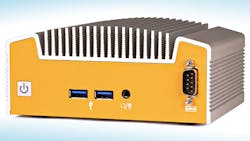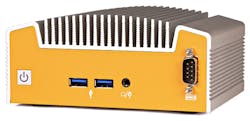What are the Differences Between Consumer and Industrial NUCs?
This file type includes high-resolution graphics and schematics when applicable.
When Intel chose to leap into the burgeoning small-form-factor PC market in 2012 with its Next Unit of Computing (NUC) platform, the move was met with a mix of surprise and bemusement. With a solid hold on the CPU manufacturing segment, it was somewhat surprising that the processor giant would jump headlong into full system manufacturing and distribution.
There was also initial skepticism that the 4-in. × 4-in. motherboards would catch on with other hardware manufacturers. But in the years that followed, NUC-based hardware began to crop up in many forms, as other motherboard manufacturers started releasing their own versions of the increasingly popular board.
At the same time, the industrial computing segment began to take notice of Intel's new platform. While small-form-factor systems based on Mini-ITX and Pico-ITX boards were nothing new, the NUC offered a unique combination of size and performance that made it ideal for installation in space-constrained environments that still required a fully featured, versatile PC. In addition, where previous generations of mass-produced, proprietary small-form-factor PCs often required customization to best serve a given application, NUC offered a fixed I/O configuration that didn't rely on utilizing onboard pin headers to achieve a suitable I/O coastline.
The problem for early NUC adopters was that the systems, and in particular the enclosures, were not designed for the type of challenging conditions commonly found outside of an office setting. Plastic cases, complete with cooling fans and air vents, create problematic reliability concerns when installed on a busy manufacturing floor, or when mounted to the wall in a dust-filled wood mill. Fortunately, industrial computer (IPC) manufacturers were equally intrigued by the NUC platform and it wasn't long before industrial NUC systems hit the market, distinctly engineered to offer a more durable, more reliable computing platform thanks to a range of key design considerations.
Industrial Materials and Configurations
The most obvious departure from a consumer NUC to its industrial counterpart is the enclosure. Intel's own NUC computers utilize a mix of polycarbonate and plastics in addition to metal components, materials that are perfectly adequate for the vast majority of consumer applications. However, in a more demanding industrial environment, where systems may be subject to shock, vibration, or even impacts by machinery or tools, industrial NUC systems most commonly employ steel or aluminum for the chassis, lid, or both. A range of stamping, laser cutting, and extrusion techniques are used to create industrial NUC enclosures, depending on the specific needs and budget of the end user.
In addition, while the consumer NUC systems from Intel follow a standardized form factor and aesthetic, industrial NUC systems from companies like Logic Supply and Jetway offer IPC users additional capabilities, such as expansion bays for storage, specialized add-on cards, or industry-specific I/O (Fig. 1).
Other unique environmental concerns should be considered when designing any IPC system. Protection from interference is an important feature for devices being installed in and among other equipment. Industrial NUCs may utilize double right-angle interfaces at enclosure joints to limit RF and electrostatic discharge (ESD), which can cause signal disruption or even data loss if internal components are not properly isolated (Fig. 2). Anodized aluminum and nickel-plated steel parts, as well as specialized ESD shielding gaskets, further help to prevent interference from entering the computer.
Engineering Reliability
Computer crashes are a frustrating experience for anyone, but the ramifications of unreliable hardware in the industrial computing space can cost a business an incredible amount of both time and money. Hardware failures can bring a manufacturing line to a halt, result in unusable product, or render data inaccurate or inaccessible. The reliability of a computer system is influenced by a wide range of variables, and industrial PC manufacturers have worked hard to eliminate the most common points of failure in order to maximize uptime.
One of the most impactful reliability improvements that many industrial NUCs employ is the removal of all moving parts, including the fan and spinning platter drives. The use of mSATA and M.2 standards allows for a range of storage options without the inherent vulnerabilities of HDDs. Further, by utilizing passive cooling technology, many industrial NUC enclosures are able to eliminate all extraneous openings in the case, which would otherwise be required to facilitate airflow in a traditional fanned (or actively cooled) thermal solution.
Custom-machined heatsinks or heat pipes are employed to transfer thermal energy from internal components (most commonly the CPU) directly into the system's chassis, where it can be dissipated by the surrounding air. The elimination of ingress points for airborne contaminants helps to keep out dust, grease, chemicals and corrosives that can quickly build up on internal components, causing overheating or electrical shorting.
Speaking of heat, operating temperature is another key concern in industrial computing. While the currently available NUC motherboards all hover around 0°C for their low operating temperature range, and 40-50°C on the high end, motherboard manufacturers are beginning to experiment with wider ranges for use in less-temperature-controlled environments. These types of extreme temperature applications are becoming increasingly common among industrial PC users as more and more systems require centralized processing and data management in the field.
Lifecycle Differences
Industrial computing projects rely on component standardization to ensure consistent product delivery and performance. Many industrial certifications and regulatory tests also require a device to be locked down to a set configuration in order to be approved. However, consumer electronics, especially computer hardware, rarely feature a product lifecycle of longer than a year or two.
While consumer NUC systems from Intel offer anywhere from one to three years of lifecycle support, some industrial NUC products are able to offer a full five-year lifecycle. A longer product lifecycle means that integrators can more easily standardize on a particular hardware solution and be assured that the components they've integrated will be available for future orders or replacements.
Connectivity Options
The final key difference between consumer and industrial NUC PCs is one of the first things that most consumer computer users will notice—the I/O. The connectivity needs of IPC integrators and solution providers tend to be very different than those of the average personal-computer user. While USB, HDMI, and LAN are certainly commonplace in consumer and industrial NUC systems, early versions of the NUC featured I/O configurations targeted much more directly at home users looking to build home-theater PC (HTPC) devices and the like.
In contrast, legacy infrastructure integration in a machine shop or industrial automation facility often requires the use of connectivity standards commonly seen as antiquated in the consumer space, such as Serial Ports or DVI. Digital input/output (DIO) is also a frequent feature in today's industrial systems, allowing for versatile individualized programming and control.
Conclusion
Intel's Next Unit of Computing combines considerable performance with a small-form-factor motherboard that can still offer the level of connectivity required for a wide range of applications, both consumer and industrial. However, Intel's own consumer hardware, and that of other manufacturers who have embraced the form factor, can only go so far when being implemented in more challenging industrial environments. A number of distinct differences in build quality, reliability, lifecycle, and connectivity need to be considered when selecting a hardware solution, so it's important to understand that not all NUCs are created equal.
Looking for parts? Go to SourceESB.
About the Author
Tosha Hawley
Product Manager
Tosha Hawley is a member of the Product Management team at Logic Supply, an industrial PC manufacturer. She works with vendors from around the world to select and source industrial hardware and components that meet Logic Supply’s strict reliability and performance standards.




